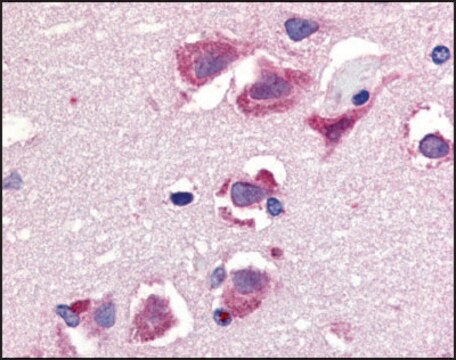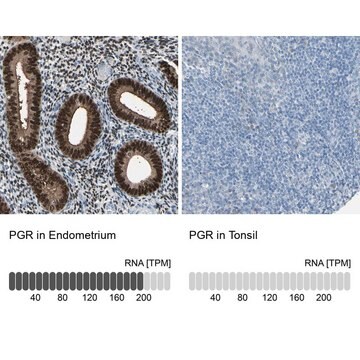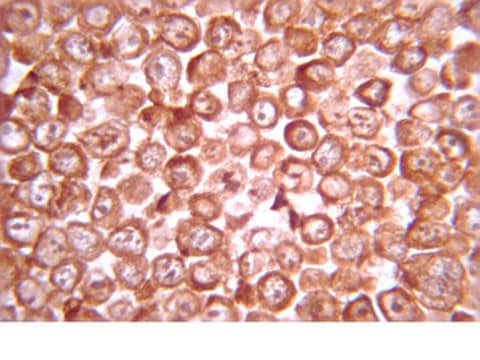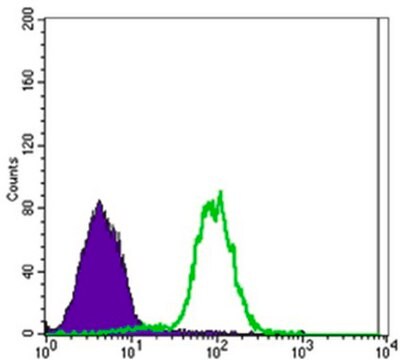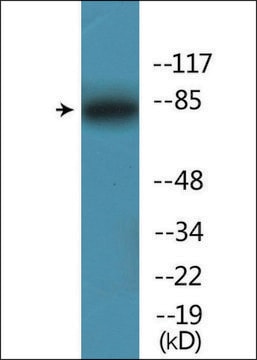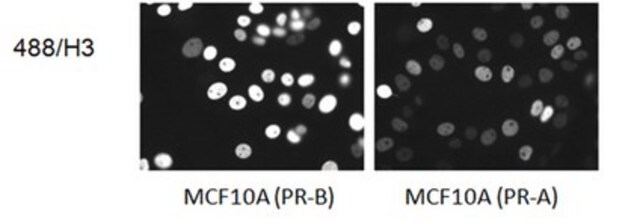MABS1234
Anti-Progesterone Receptor B Antibody, clone 250/H11
clone 250/H11, from mouse
Sinonimo/i:
Progesterone receptor, PR, Nuclear receptor subfamily 3 group C member 3, Progesterone Receptor B
About This Item
Prodotti consigliati
Origine biologica
mouse
Livello qualitativo
Forma dell’anticorpo
purified immunoglobulin
Tipo di anticorpo
primary antibodies
Clone
250/H11, monoclonal
Reattività contro le specie
human
tecniche
immunocytochemistry: suitable
western blot: suitable
Isotipo
IgG1κ
N° accesso NCBI
N° accesso UniProt
Condizioni di spedizione
wet ice
modifica post-traduzionali bersaglio
unmodified
Informazioni sul gene
human ... PGR(5241)
Descrizione generale
Specificità
Immunogeno
Applicazioni
Immunocytochemistry Analysis: A representative lot stained paraformaldehyde-fixed and Triton X-100-fixed MCF10A cells engineered to express progesterone receptor isoform B (PR-B), but not MCF10A cells engineered to express isoform A/PR-A by fluorescent immunocytochemistry (Courtesy of Dr. Dean Edwards, Baylor College of Medicine, USA).
Western Blotting Analysis: A representative lot detected endogenous progesterone receptor isoform B (PR-B) in human breast cancer T47D cell lysate, as well as exogenously expressed PR-B in transfected DCIS.COM human ductal carcinoma in situ (DCIS) breast cancer cells, but not in PR-A-transfected or untransfected DCIS.COM cells (Courtesy of Dr. Dean Edwards, Baylor College of Medicine, USA).
Signaling
Developmental Signaling
Qualità
Western Blotting Analysis: 2.0 µg/mL of this antibody detected progesterone receptor isoforms B (PR-B), but not isoform A (PR-A) in human breast cancer T47D cell lysate.
Descrizione del bersaglio
Stato fisico
Stoccaggio e stabilità
Altre note
Esclusione di responsabilità
Not finding the right product?
Try our Motore di ricerca dei prodotti.
Codice della classe di stoccaggio
12 - Non Combustible Liquids
Classe di pericolosità dell'acqua (WGK)
WGK 1
Punto d’infiammabilità (°F)
Not applicable
Punto d’infiammabilità (°C)
Not applicable
Certificati d'analisi (COA)
Cerca il Certificati d'analisi (COA) digitando il numero di lotto/batch corrispondente. I numeri di lotto o di batch sono stampati sull'etichetta dei prodotti dopo la parola ‘Lotto’ o ‘Batch’.
Possiedi già questo prodotto?
I documenti relativi ai prodotti acquistati recentemente sono disponibili nell’Archivio dei documenti.
Il team dei nostri ricercatori vanta grande esperienza in tutte le aree della ricerca quali Life Science, scienza dei materiali, sintesi chimica, cromatografia, discipline analitiche, ecc..
Contatta l'Assistenza Tecnica.
